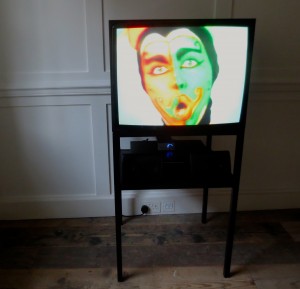There are certain challenges surrounding the display of video art and it is up to curators and art technicians to be practical and creative at the same time. It is unfortunate that the equipment needed to show video art, projector or screen, is sometimes clunky and fits less than seamlessly into a gallery space – the worst examples are taped down wires running across floors or a suspicious drapery over a projector. Video work also often comes with sound. This may include hanging headphones or installing small speakers that play out into the gallery, but attempt not to interfere with other works.
Ed Atkins’s solo show at the Serpentine gallery this year (11 June – 25 August 2014) was an example of how video work can be displayed well. Firstly, it was a solo show. Atkins took over the space and the sound could carry everywhere. A group show of video art would have to be more democratic, which would mean small speakers or headphones. Secondly, the sound for all the works was synced and it was a good quality sound. It echoed and resounded around the gallery making sense to the viewer wherever they were standing, creating a seamless experience. There was no unwelcome sounds invading other works or tinny headphones to reluctantly pick up. Thirdly, the videos were not constricted to flat screens but projections and large screens were used together and in original ways. Moving through the space and viewing the works was a natural experience, there was no curtains or clunky television sets.
“It echoed and resounded around the gallery making sense to the viewer wherever they were standing, creating a seamless experience.”
It’s more of a challenge for collections and group shows to work with video art. Video work must be integrated with other types of work, but it cannot dominate the space and sound of the gallery. A visit to the Tate Modern and Tate Britain revealed a range of display strategies, some more successful than others. Derek Jarman’s Blue (1993) at the Tate Modern (on display 21 October 2013 – 5 October 2014) is a room off a the main gallery route, a purpose built video art room, it’s dark and soundproof inside and a text outside describes the work with running time and importantly start times, so you can time yourself if you want to watch it from the beginning. While the room is obvious, you do not have to walk through it, which leaves viewers with no shadowy distractions. In the recent display at Tate Britain, a video work played inside an unfortunately clumsy back felt box which protruded out into the rectangular room. The sound played inside the box, but filtered into the rest of the room. An example of a challenging space and an awkward display.
Video art can also be displayed with creativity. At Yuri Pattison’s solo show at Cell Project Space (18 September – 2 November 2014), a video work was displayed inside a store cupboard, which worked well with the content of the work. He said: “I had this room as a studio for six weeks, so I found that space and began to think how it could become an installation. It relates to the work which is about a hidden workforce labour.”
“Watching video art online, on your laptop in bed or on your sofa is brilliant, you have less control over sound, but you definitely have someone’s attention.”
I asked him more generally about displaying video work: “I make work so it can be displayed in a certain way. My video work is all non-linear and non-narrative for that reason. I do really like narrative and linear video art, but I can’t really make it because I don’t think that way. Linear and narrative video is particularly difficult to display in a gallery because you don’t have that attention span from the viewer. There was a survey, and most people spend about two minutes watching a video. Watching video art online, on your laptop in bed or on your sofa is brilliant, you have less control over sound, but you definitely have someone’s attention. Links to most of my work exist online for that reason, I feel they should be accessible and they should be viewed.”
“When I haven’t had full control over display strategy then it’s different. I have had arguments where I didn’t want to use headphones, but in a group show you have to make decisions based on the other works and be respectful and make a compromise.”
by Harriet Thorpe











